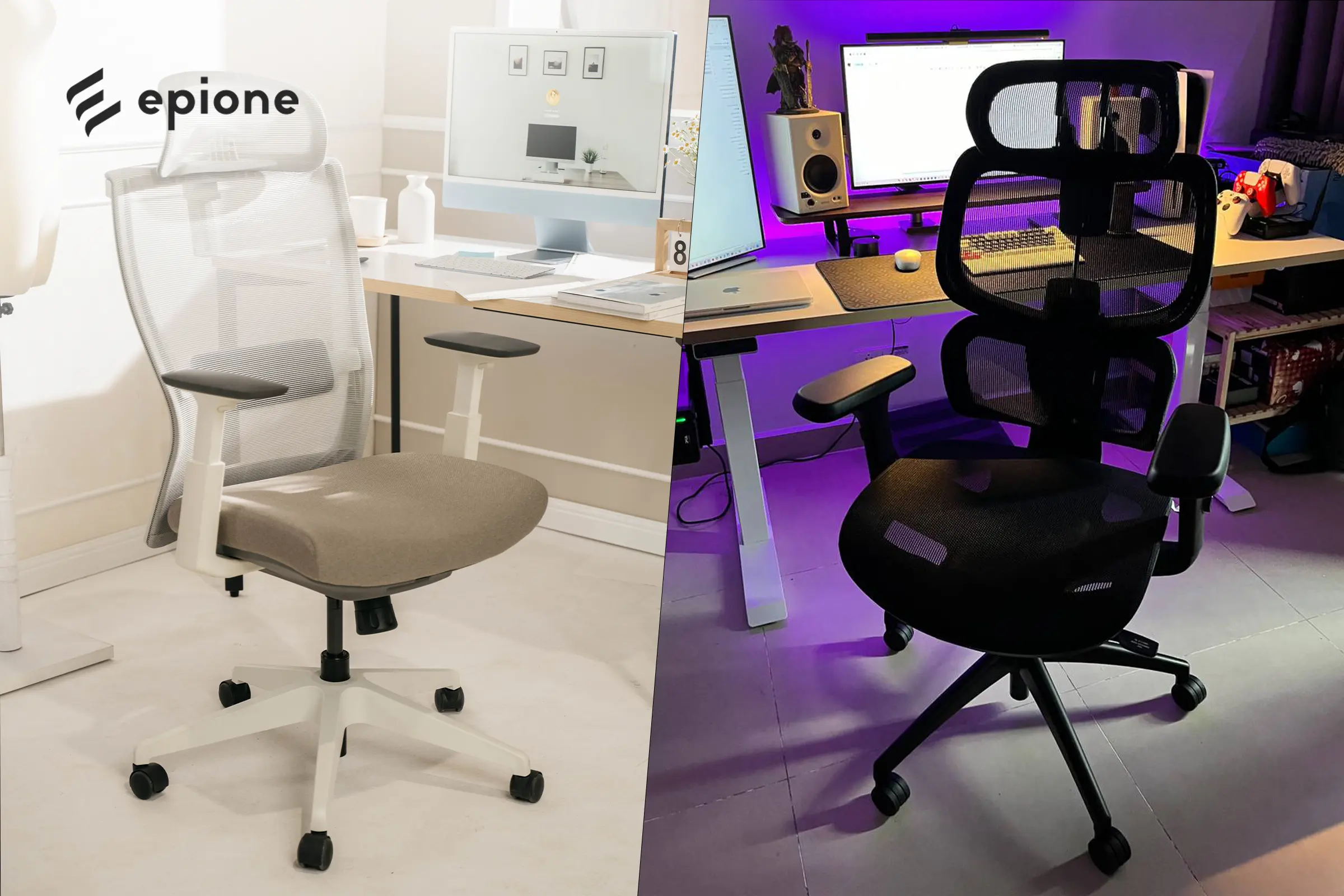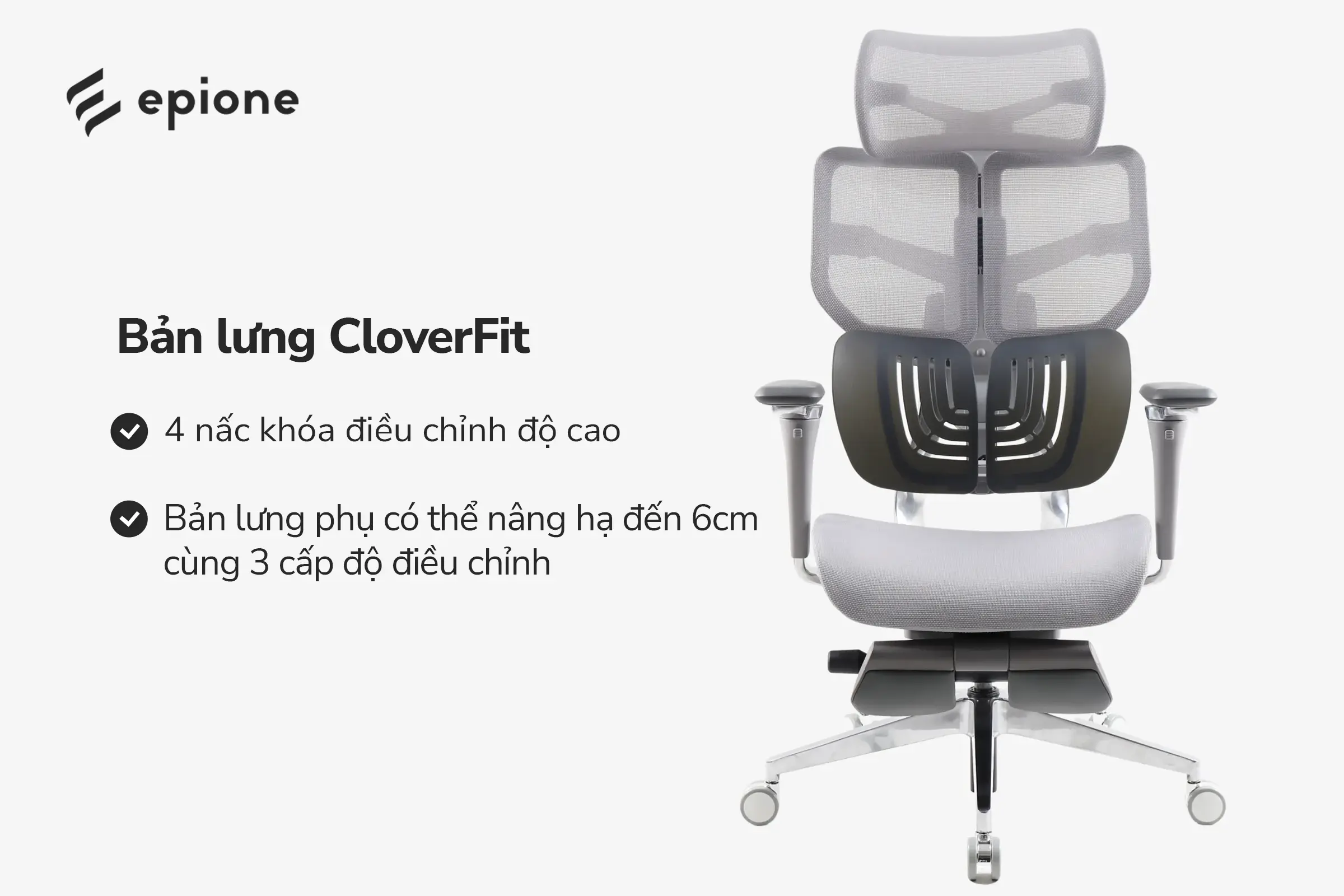When researching the different types of ergonomic chairs available on the market, you may be confused by the different backrest options. This article will give you an overview of the different types of backrests, the benefits they bring, their pros and cons, and from there make the most appropriate decision?

Based on the popular chair lines today, the ergonomic chair back structure can be divided into 3 main types as follows:
- Backrest without lumbar support
- The seat back has lumbar support but is not adjustable.
- The backrest has lumbar support and can be customized as desired.
Based on the above structure, I will divide the back of the chair into two separate parts: the back of the chair and the lumbar support to help you easily learn about the uses, benefits, and classification of each part.
Ergonomic chair back
1. Uses of the chair back
The backrest is one of the main components of an ergonomic chair in particular and an indispensable component of a chair in general. In addition to being a solid support for the back, it also helps maintain the natural curve of the spine, helps prevent back pain and brings comfort to the user experience. In an ergonomic chair, the backrest goes beyond these benefits. Specifically, it possesses practical benefits such as:
- Helps maintain correct posture: Ergonomic chairs have a high back design, some also have a flexible backrest that supports the lower back, providing a healthy spine and shoulders. Most ergonomic chairs allow you to control the recline angle or resistance as desired.

Guide to ergonomic sitting posture.
- Reduce the risk of musculoskeletal problems: Smart chair backrests help reduce the risk of developing conditions such as chronic back pain, herniated discs, and sciatica by providing proper support and alignment.
- Improve blood circulation: A properly designed backrest promotes good blood circulation by supporting the natural curve of the back and reducing pressure on blood vessels. This can help prevent numbness and tingling in the legs.
- Helps reduce stress and fatigue: The reclining, resistance and flexible customization features allow users to change their sitting position periodically, reducing fatigue and increasing alertness, helping you focus on your work and feel less discomfort or pain.
2. Factors to consider when choosing to buy
When choosing an ergonomic chair, there are three elements of the backrest that you need to pay attention to: the reclining mechanism, its height and width.
An ergonomic chair has 5 tilt mechanisms, including a central tilt mechanism, a knee-holding tilt mechanism, a multi-function mechanism, a synchronous tilt mechanism, and a weight-sensitive mechanism. Depending on the type, the backrest can be tilted up to 135°. In Vietnam, most ergonomic chairs have a backrest equipped with a weight-sensitive mechanism because it is the most optimal mechanism for working and studying posture.

3 reclining modes on Epione FortisChair
The best backrests are usually 18 to 22 inches high and 12 to 19 inches wide. Some high-end ergonomic chairs also have the ability to raise and lower the entire backrest, making it easy to adjust to your body.
Ergonomic chair lumbar support
1. Uses of lumbar support
Lumbar support is a device designed to reduce pressure on the lower back and improve spinal alignment. The lumbar spine consists of five vertebrae between the rib cage and the pelvis, labeled L1 to L5. It supports the weight of the entire body, connects other bones together, and allows for flexibility and range of motion. It also helps protect the spinal cord, a part of the central nervous system that controls the activities of the human body.
In addition, it also brings many other benefits such as:
- Improve sitting posture: Normally, we tend to sit hunched over and do not keep our body in the correct posture when working and studying. Lumbar support integrated into ergonomic chairs can significantly improve sitting posture by hugging the curve of the lower back, helping to reduce pain caused by poor posture.
- Injury prevention: Using a lumbar support is a good preventative measure to reduce the risk of back injuries due to a sedentary lifestyle such as chronic back pain and spinal disorders.
- Improve productivity: Chronic pain can be distracting, stressful, and make it difficult to concentrate on work. Lumbar support can reduce pain levels, provide comfort, and help you work more productively and efficiently.
- Improve blood circulation: A quality lumbar support can also help improve circulation by distributing your weight evenly while you sit. It helps reduce fatigue, stiffness, and cramps caused by sitting in one position for too long.
2. Lumbar support classification
There are three types of lumbar support in ergonomic chairs: fixed, adjustable, and dynamic. When choosing an ergonomic chair backrest, keeping the following principles in mind will help you make the right choice:
- The waist reach from 0.6inch to 2inch (1.5cm to 5cm) will suit everyone.
- The female lumbar spine (lordosis) tends to curve more and will benefit from more pronounced lumbar support.
- People with a higher BMI (body mass index) will often prefer higher lumbar support.
Right after this, I will analyze the advantages and disadvantages of each type of lumbar support to see which type is worth investing in when choosing to buy an ergonomic chair!
2.1. Fixed lumbar support

Epione FolioChair without lumbar support (left) and Epione FortisChair with lumbar support (right).
As the name suggests, fixed lumbar support is built into the chair and is not adjustable. It is usually found in chairs that are affordable (between $300 and $400) for most people. These lumbar supports are not suitable for everyone, so you may not get much benefit from them.
Some chairs that stand out in this segment will be equipped with a separate backrest, providing more optimal support for the back. The Epione FortisChair is a typical example, possessing an independent backrest that is researched with the purpose of focusing on supporting the hips and lower back of the sitter. However, it also has certain limitations because it cannot be moved or customized as desired.
2.2. Adjustable lumbar support

Illustration of Epione EasyChair 2.0 backrest
Adjustable lumbar support (also known as a backrest) can be adjusted to accommodate different body sizes and shapes. You can completely change the position of the backrest according to your preferences regarding factors such as:
- Height: Move the backrest vertically to fit the lumbar area.
- Tension/Stiffness: Adjust with a knob or dial. This controls how firm or loose the backrest is.
- Depth: The degree of extension outward or inward with respect to the lower back.
2.3. Flexible lumbar support
The ability to automatically adjust is a prominent feature of the flexible lumbar support. It can be considered a superior step forward of the adjustable lumbar support version. This type of lumbar support provides flexible changes in firmness and depth to suit the user's body shape and size according to each body movement without the need for manual adjustment.
An ergonomic chair with such smart and convenient features naturally comes with a high price tag for the average user. The flexible lumbar support is the most expensive of the four types of lumbar support. It can have anywhere from 2 to 4 pieces that can be adjusted individually for different parts of your back.

Illustration of the CloverFit backrest on the Epione AliusChair
In addition to its outstanding functionality, the exterior design of this chair with its unique backrest is also very different. For example, the CloverFit backrest of Epione AliusChair is shaped like a four-leaf clover, and can be flexibly adjusted in height with 4 locking levels to help stabilize the sitting posture from the shoulders to the waist. Each part of the chair backrest that contacts the body can be independently elastic, automatically adjusting to the curve of the spine, providing comfort and precision for each position.
2.4. External lumbar support

Ergonomic chair backrest cushion
If you are not ready to invest in a chair with a built-in backrest, purchasing a replacement pillow or cushion is a viable solution. This is a cost-effective and easy approach, but it is not recommended because the support is often minimal and the results are often not noticeable. Furthermore, constantly moving the pillow or cushion to fit the spine to some extent will reduce the sitter’s ability to concentrate, affecting overall productivity.
Which type of ergonomic chair back should I choose?
If you arrange the ergonomic chair options in ascending order of price and corresponding features, the order would look like this: Chairs without backrests (price range 1.5 million to 2.7 million) – Chairs with backrests but not customizable (price range 3 million to 4 million) – Chairs with backrests and customizable as desired (price range over 4 million).
Depending on each person's budget and usage needs, you will be able to make the right choice. For example, if you are a student and do not have much budget, then an ergonomic chair without a backrest is a reasonable choice. If you are a developer or someone who sits for long periods of time, a chair with a backrest will be the best choice.
Investing in a chair with proper lumbar support will always be a “profitable investment” for those who have to sit for long hours at a desk! Through this article, Epione hopes that you have an overview of the types of chair backs available on the market, the benefits they bring as well as the advantages and disadvantages of each type to make the best decision for your needs.
